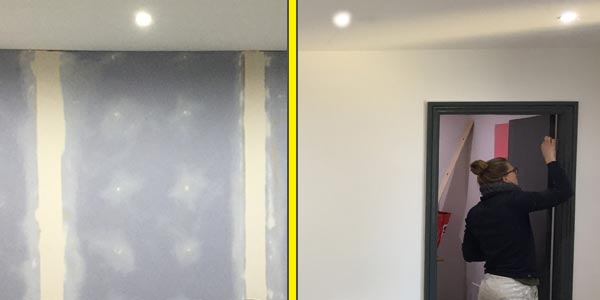Tapered edge plasterboard, also known as dry lining boards, are a type of plasterboard with a recessed edge, that allows the joints to be filled for a seamless finish.
The tapered edges, are found on the long sides of the plasterboard. However, the top and bottom of the board, has a normal straight edge.
In most properties, this type of plasterboard is fitted upright. The boards are 2400mm in length, which means they are roughly the average ceiling height in the UK. So, in most cases you can board floor to ceiling with one plasterboard.
A standard size board, with a length of 2400mm, is usually 1200mm wide. Therefore, if you are fitting to studwork, you will be hitting an upright on the edges of your board. This will work, regardless of whether the studs are spaced at 400 or 600mm centres.
The main advantage with this type of plasterboard vs a straight edged board, is you don’t need to skim. Instead you can tape and fill the joints. Once the joint filler goes off, it can be sanded to a smooth flat surface and decorated.
The image below shows a wall that I personally built. It was dry lined and not skimmed and my decorator friend painted straight on to the boards. I am sure you will agree, the finish looks very good, making this an ideal choice for someone who is not a skilled plasterer.

How to fit tapered edge plasterboard
Fitting a tapered edge plasterboard, is no different to fitting a standard straight edged board. You have two choices for fixings:
- Plasterboard nails
- Drywall screws
The latter is far more common in this day and age. Also, due to the boards not being plastered, a drywall screw, with a countersunk head, will be much better for filling and sanding.
Just like any other plasterboard fixings, your screws should be fixed in rows, that correspond with the studs behind them. This means a plasterboard will have 4 rows of screws when fixing to a 400mm centre stud wall. Also, screws in each row should be spaced by roughly 300-400mm.
Two of these rows will be inside the tapered edge, which will be hidden by the filler. The remaining two rows, in the middle of the board, will need filling manually. I personally use the same filler that is used for the jointing.
If the board needs shortening for lower ceilings, you should place the cut edge at the bottom. Also, if the ceiling is slightly higher and the board needs lifting, or if it needs a strip adding. This should also be at the bottom, as you will likely be able to hide it well with the skirting boards.
Can you use tapered edge plasterboard on a ceiling?
In theory, you can use tapered edge boards on a ceiling, there is nothing stopping you fixing them up. However, in most cases, it won’t be practical. Unless you are boarding a small ceiling, where you can take advantage of full boards, otherwise, you are going to end up with square edged joints.
It is more difficult to fill square edged joints without skimming. Therefore, you are usually better off with a standard plasterboard for a ceiling. Following this, you can hire a plasterer to skim it for you, if you are unable to do the work yourself.
Even if you are fitting tapered edge boards on to the walls. Its usually advised to board and skim the ceiling for the best finish.
With that said, it is possible to fill square edged joints. It will just require a little more skill to achieve a good quality finish.
Conclusion
Tapered edged plasterboards are not tapered on all four sides. They only have the recessed edge on the longer sides of the board. This is because, the boards are generally stood upright and fixed floor to ceiling. Which means, they do not require a taper at the top and bottom of the plasterboard.
The main advantage of a tapered edge board, is they can be filled and decorated without the need to skim plaster. This can save significant time and money, and it’s a pretty easy job for the average DIY’er.




